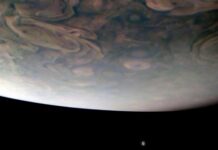NASA’s Milestone: Over 5,000 Exoplanets Discovered – An Informative Overview
In March 2022, NASA celebrated a monumental achievement in the field of astronomy by surpassing 5,000 confirmed exoplanets. This milestone marks a significant leap in our understanding of the universe and the potential for finding life beyond our solar system. To commemorate this achievement, NASA has released a data sonification project that allows us to experience the pace of these discoveries through an innovative blend of music and animation.
Understanding Exoplanets
Exoplanets are planets that orbit stars outside our solar system. The discovery of these celestial bodies has revolutionized our understanding of the cosmos, offering insights into the formation and evolution of planetary systems. NASA’s Kepler Space Telescope and the Transiting Exoplanet Survey Satellite (TESS) have been instrumental in identifying these distant worlds.
The Sonification Project
NASA’s data sonification project transforms the discovery timeline of exoplanets into a musical experience. In this unique animation, each exoplanet is represented by a musical note. The animation spans decades of discoveries, with circles indicating the location and size of each planet’s orbit. The color of these circles represents the method used to detect the exoplanet, while the pitch of the musical notes correlates with the length of the planet’s orbit – lower notes signify longer orbits, and higher notes indicate shorter orbits.
This creative approach not only provides a visual representation of the discoveries but also an auditory one. The music allows listeners to perceive the tempo and frequency of exoplanet discoveries over time, making the data more accessible and engaging to a broader audience.
Detection Methods
The different colors in the animation represent various detection methods used to find exoplanets. Here are some of the primary techniques:
- Transit Method: This is the most common method, where astronomers observe a star’s light dimming as an exoplanet passes in front of it. This temporary dip in brightness indicates the presence of a planet.
- Radial Velocity Method: Also known as the Doppler method, this technique measures the star’s wobble caused by the gravitational pull of an orbiting planet. This wobble affects the star’s light spectrum, providing clues about the planet’s existence.
- Direct Imaging: This method involves capturing images of exoplanets by blocking out the star’s light. It is challenging due to the brightness of stars compared to the planets.
- Gravitational Microlensing: This technique uses the gravitational field of a star to magnify the light of a background star, revealing the presence of an exoplanet.
- Astrometry: This method involves precisely measuring the position of a star in the sky and detecting its slight movement caused by an orbiting planet.
The Importance of Exoplanet Discoveries
The discovery of over 5,000 exoplanets is more than just a number; it represents the vast diversity of planetary systems in our galaxy. These discoveries have revealed a wide array of exoplanets, from gas giants larger than Jupiter to rocky planets similar in size to Earth. Some exoplanets are located in the habitable zone of their stars, where conditions might be right for liquid water – a key ingredient for life as we know it.
These findings have profound implications for the search for extraterrestrial life. By studying exoplanets, scientists can better understand the potential for life elsewhere in the universe and the factors that make a planet hospitable. Additionally, these discoveries help refine our models of planet formation and the dynamics of planetary systems.
Public Engagement and Education
NASA’s sonification project is an excellent example of how complex scientific data can be made accessible and engaging to the public. By converting data into sound and animation, NASA not only celebrates its achievements but also educates and inspires people about the wonders of the universe.
For those interested in experiencing this unique blend of science and art, the sonification project is available as a video. You can watch the animation and listen to the musical representation of exoplanet discoveries in 3D here.
Expert Reactions
The scientific community has lauded NASA’s efforts in making exoplanet data more accessible. Dr. Michael Meyer, a professor of planetary science, remarked, "The sonification project is a brilliant way to engage people with the data. It turns abstract numbers into something tangible and emotional."
Similarly, Dr. Natalie Batalha, an astrophysicist who worked on the Kepler mission, stated, "This project not only celebrates our achievements but also underscores the importance of continued exploration. Each note in the sonification represents a world with its own story, waiting to be discovered."
Future Prospects
The journey of exoplanet discovery is far from over. With advanced telescopes like the James Webb Space Telescope (JWST) set to launch soon, the future holds even more promise. The JWST will provide unprecedented insights into the atmospheres of exoplanets, searching for signs of habitability and potential biosignatures – indicators of life.
Furthermore, missions like the European Space Agency’s PLATO (PLAnetary Transits and Oscillations of stars) and NASA’s Wide Field Infrared Survey Telescope (WFIRST) will continue to expand our catalog of exoplanets and refine our understanding of these distant worlds.
Conclusion
NASA’s achievement of discovering over 5,000 exoplanets is a testament to human curiosity and the relentless pursuit of knowledge. The data sonification project adds a creative dimension to this scientific milestone, making it accessible and engaging for everyone. As we continue to explore the universe, each discovery brings us closer to answering profound questions about our place in the cosmos and the potential for life beyond Earth.
For those eager to delve deeper into the world of exoplanets and experience the sonification project, you can watch the video here. This innovative approach not only celebrates past achievements but also sets the stage for future discoveries that will continue to reshape our understanding of the universe.
For more Information, Refer to this article.



































